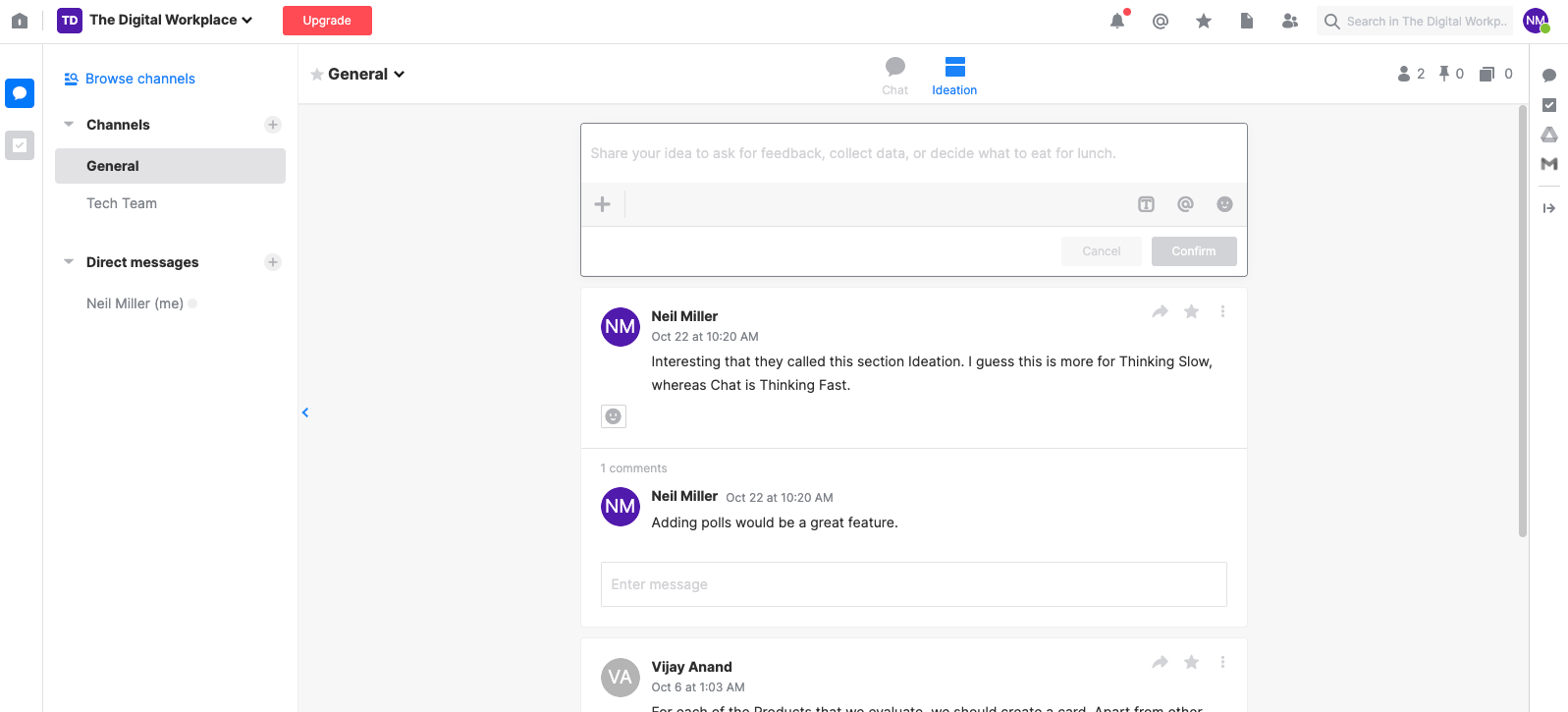Communication challenges have changed forever. Managers in the digital era have an entirely new set of struggles that require new rules.
It isn’t as simple as switching all your conversations to digital. When you are co-located, people talk to each other by default. But in remote teams, they don’t. In fact, if you don’t communicate on a remote team, you don’t exist.

Mike Knoop, co-founder at Zapier says, “The biggest downside you have to solve with remote work is communication. Everything else gets pretty easy.”
So, how do you overcome communication challenges on a remote team? You can’t just find little hacks here and there; you need to rebuild your approach to digital collaboration.
Remote team communication is fundamentally different
Remote communication must be intentional, planned, and organized. It switches from primarily talking to writing. Claire Lew, CEO of Know Your Team, points out that remote teams are “write-first”, while co-located teams are “speak-first”.
DHH, CTO at Basecamp, said, “Being a good writer is an essential part of being a good remote worker.” You will not succeed at remote work unless you write well and have good communication practices.
As we’ll explore, great communication on digital teams isn’t just about converting everything you did in the office to digital platforms. That’s just a Level 2 digital workplace. You need to think about how digital tools have created new issues and forced the need to restructure your whole approach to communication.
Virtual team communication challenges
Digital collaboration presents four unique remote team communication challenges that leaders of the past simply didn’t have to worry about.
The solutions aren’t easy or simple. They take constant adjustment and diligence. You never solve the problem fully, but only find a better way to solve it than you did before.
As a manager of a remote team, your job is to provide the best framework to solve these challenges, and constantly adapt your plan as the environment changes.
While you should have a solid set of ground rules about digital collaboration, even more important is that you model the behavior you want to see. Nothing matters more than the leader demonstrating healthy communication practices.
Remote team communication challenge #1: Response time
In pre-digital days, you might expect immediate responses from face-to-face, something within the day for a phone call, or in 2-3 days for a memo.
A simple conversion to digital means you assign similar response times to things like email, instant messages, and posts on internal channels.
But stop and think about how digital has changed the nature of response times. A conversation about a document can be held right on the document over the space of 48 hours. You can communicate with team members in every corner of the world at any time. You can give a quick reaction to someone’s post instead of attending a meeting. Since digital workplaces highly value time, you start to wonder if we are spending it wisely.
What’s competing
At the heart of the challenge of response times is the difference between synchronous and asynchronous communication. Synchronous means happening in real-time (like a live conversation). Asynchronous means people can jump in and out of the conversation (like a Reddit page).
Synchronous communication is great because it gives a sense of instant alignment. The real-time nature also is important for remote team members who might feel lonely throughout the day. Decisions can happen much faster; a ten minute phone call can replace three days of email exchanges.
However, synchronous communication is really demanding on your time and attention. If your conversations are text based, you’re probably drowning in notifications all day long.

Asynchronous communication is a calmer approach. People can take time to respond. It also encourages a slow thinking mode, which can be very helpful. Asynchronous communication doesn’t force your whole team to be active at the same time, which helps with time zones and personal preferences.
However, asynchronous conversations can elongate discussions and make people feel disconnected.
Who wins in a fight?
In all of these challenges, there is a clear default winner if you aren’t intentional. For response times, most people naturally value speed, which means synchronous wins. If you don’t define response times, people are going to use the tools which give them the fastest responses.
Solving response time communication challenges
Ok, so video calls are definitely synchronous.
Snail mail is definitely asynchronous.
But what about messaging? Email? Discussion boards?
Welllllll… it depends, right? Email seems obviously asynchronous, but remember the days of constantly refreshing your inbox and having one line messages go back and forth?
Or a chat tool like Slack seems like it is synchronous. Instant desktop notifications scream that you need to reply NOW! But other features like Status, Do Not Disturb, or Remind Me Later, suggest that it’s also trying to be asynchronous.
Remote teams need both options, and most digital communication tools can be used both ways. That’s why it’s so important for remote team leaders to set the ground rules for each tool.
- Which tool will you use for synchronous and asynchronous communication?
- Is there a particular window of time when you should expect a shorter response time than others?
- How will you handle synchronous communication for those who work in different time zones?
As an example, here are Buffer’s rules for how they use Slack.
Remote team leaders also need to set the example for good communication practices.
- How quickly do you respond to different communication types?
- Are you unconsciously rewarding people who respond faster than others?
- Have you ever apologized for interrupting someone when they respond too quickly?
Remote team communication challenge #2: Durability
Think about how digital has changed quick conversations. These used to happen only in-person or on the phone. Now, the majority of quick conversations happen in digital platforms where there is a permanent record.
This presents a new challenge, because we often leave important insights, data, and decisions sitting in those platforms, assuming we can access it later.
But any modern worker knows that it’s not that easy to scour through your email or Slack threads to find what someone said.
What’s competing?
In this challenge, the competition is between enduring and fleeting communication. Enduring communication needs to be crisp, clean, and easily accessible. These are your policies, core decisions, and strategy plans. Fleeting communication is ephemeral and could disappear without anyone noticing. These are all the chat messages it took to achieve those documents.
Think about all your archived email conversations, text messages, and chats. If they all were suddenly deleted, how would that affect you?
In an ideal environment, it might set you back a little, but not much because you’ve stored your really important stuff (enduring communication) somewhere else. Fleeting communication is the chatter that it takes to get to the big stuff.
Remote teams generate a lot of communication, and a great manager needs to solve the problem of what needs to be placed in a highly durable format, and what can be tossed away.
Who wins in a fight?
Organizations default to ease, so fleeting communication usually wins. That’s why we tend to just leave important information in inboxes or messaging channels.
Solving durability communication challenges
You need to help your team clearly distinguish between the two types, and define where durable remote communication should be stored.
Set the ground rules. Get your team used to asking the question, “Will I need this later?”. If the answer is “yes”, then you want to pull that out and store it somewhere else. This might be a Google document in a shared folder, or on a remote communication tool that is more geared towards durable communication like Notion or Coda.
Set the example. When you finish a meeting, write up the notes and put them in a durable place that can be easily searched.
Remote team communication challenge #3: Fidelity
Think about the difference between a telegram and a face-to-face conversation.
The telegram can communicate its message with words and punctuation.
A face-to-face conversation includes:
- Tone of voice
- Inflection
- Volume
- Gestures
- Pauses
- Facial expressions
- Real-time reactions to the other person
Face-to-face conversations have more signals to help encode the right message.
What’s competing?
The spectrum here is between low-fidelity (very few signals) and high-fidelity.
Video-calling is very high-fidelity, while an SMS is fairly low-fidelity. Adding emojis and GIFs into primarily text communication increases the fidelity.
Who wins in a fight?
If the default for organizations is speed and ease, then low-context communication usually wins out. This becomes a problem because low-fidelity communication often leads to misunderstandings. It’s easy to misinterpret the tone someone gave with a message, or you might miss an important facial cue that changes the meaning of the message.
Solving fidelity communication challenges
Have you ever heard someone talk about an argument they had while trading text messages? Many of those conversations deescalate when people actually talk to each other on the phone or in person. Text-only conversations leave a lot to be (mis)interpreted and if you don’t assume good intent, you can easily read bad things into what someone said.
High-fidelity communication is best when there is a chance for misunderstanding, or the message can be highly emotional, especially for virtual team communication. Situations include:
- Giving feedback
- Meetings
- Addressing touchy subjects
However, high-context communication is not very durable, takes synchronous time, and often needs to be followed up with something written.
Set the ground rules. Encourage people to switch to high-fidelity tools when the situation starts to escalate. Turn video on for meetings to give more context for others.
Set the example. When you sense a text conversation is about to get heated, ask, “Can I call you about this now?”

Remote team communication challenge #4: Access
Access has always been one of the persistent communication challenges in the workplace. Who gets access to the important files? Who is able to contact the CEO directly? Who gets invited to the meeting?
Digital tools have reshaped the way we think about access to information. You can remove a person from an important conversation with a click, or quickly give access to a shared document.
So what are the new issues that digital leaders need to address?
What’s competing
At the heart of this challenge is open vs. closed communication. Open channels are easy to access and find. Closed channels are obscufated and keep information tight.
In addition, digital leaders need to think about interoperability. This is about how your communication system can work with systems. For example, email is highly interoperable. Once someone has your email address, they don’t need to be on a special account to send you a message. Other examples are messaging platforms based on your phone number like WhatsApp or Signal. However, on a platform like Slack or Microsoft teams, only those who are a part of your account can connect.
Who wins in a fight?
This one isn’t as clear, but the edge goes to closed access.
When it comes to data, most people got used to saving files on their local drive before sharing them through email or putting them on a local shared drive. Even with tools like Google Drive or OneDrive, most people won’t share all their files by default, and will only give access when requested.
For communication, we love both. The days of Reply All emails show the power of having discussions out in the open, yet, we also swoop at the chance to have a private group chat unbeknownst to the rest of the team.
Most people prefer to work in private and only come out in the open when required.
Solving privacy communication challenges
Working in public by default is a better approach than working in private. This means keeping all your documents in shared folders and having all communication channels open.
This approach makes the flow of information easier, and allows people to find the information they need. You want your team to be as informed and empowered as they can be.
Working in public also increases trust. If you’ve been working somewhere for six months and constantly have to ask for access for documents, and then suddenly get an invitation to a secret chat group you never knew about, it’s obvious that information will be hid from you if it can. While there are plenty of legitimate reasons to control access to certain data and conversations, these should be the exception.
For interoperability, as unideal as it is, you probably need to have one system for handling communication with the outside world and a separate one for internal communication. Email still works great for those on the outside, but you should discourage (or outright ban) email to be used for internal communication.
Set the ground rules: Make all files and conversations open by default. Only use email for external communication.
Set the example: Put all of your files into a shared drive that everyone can see to increase transparency and the flow of communication. Don’t create closed channels unless it is absolutely necessary.
Level up your communication
If you don’t do anything, your communication is probably going to be dominated by synchronous, fleeting, low-fidelity, and closed communication. This is good for doing work quickly, but sets your remote team up for failure in the end.
Digital leaders have to put in the work to offer solutions that understand the nature of virtual team communication challenges.
Set the ground rules, but most importantly set the example and seek to improve the way you communicate remotely.
Communication challenges have changed forever. Managers in the digital era have an entirely new set of struggles that require new rules.
It isn’t as simple as switching all your conversations to digital. When you are co-located, people talk to each other by default. But in remote teams, they don’t. In fact, if you don’t communicate on a remote team, you don’t exist.

Mike Knoop, co-founder at Zapier says, “The biggest downside you have to solve with remote work is communication. Everything else gets pretty easy.”
So, how do you overcome communication challenges on a remote team? You can’t just find little hacks here and there; you need to rebuild your approach to digital collaboration.
Remote team communication is fundamentally different
Remote communication must be intentional, planned, and organized. It switches from primarily talking to writing. Claire Lew, CEO of Know Your Team, points out that remote teams are “write-first”, while co-located teams are “speak-first”.
DHH, CTO at Basecamp, said, “Being a good writer is an essential part of being a good remote worker.” You will not succeed at remote work unless you write well and have good communication practices.
As we’ll explore, great communication on digital teams isn’t just about converting everything you did in the office to digital platforms. That’s just a Level 2 digital workplace. You need to think about how digital tools have created new issues and forced the need to restructure your whole approach to communication.
Virtual team communication challenges
Digital collaboration presents four unique remote team communication challenges that leaders of the past simply didn’t have to worry about.
The solutions aren’t easy or simple. They take constant adjustment and diligence. You never solve the problem fully, but only find a better way to solve it than you did before.
As a manager of a remote team, your job is to provide the best framework to solve these challenges, and constantly adapt your plan as the environment changes.
While you should have a solid set of ground rules about digital collaboration, even more important is that you model the behavior you want to see. Nothing matters more than the leader demonstrating healthy communication practices.
Remote team communication challenge #1: Response time
In pre-digital days, you might expect immediate responses from face-to-face, something within the day for a phone call, or in 2-3 days for a memo.
A simple conversion to digital means you assign similar response times to things like email, instant messages, and posts on internal channels.
But stop and think about how digital has changed the nature of response times. A conversation about a document can be held right on the document over the space of 48 hours. You can communicate with team members in every corner of the world at any time. You can give a quick reaction to someone’s post instead of attending a meeting. Since digital workplaces highly value time, you start to wonder if we are spending it wisely.
What’s competing
At the heart of the challenge of response times is the difference between synchronous and asynchronous communication. Synchronous means happening in real-time (like a live conversation). Asynchronous means people can jump in and out of the conversation (like a Reddit page).
Synchronous communication is great because it gives a sense of instant alignment. The real-time nature also is important for remote team members who might feel lonely throughout the day. Decisions can happen much faster; a ten minute phone call can replace three days of email exchanges.
However, synchronous communication is really demanding on your time and attention. If your conversations are text based, you’re probably drowning in notifications all day long.

Asynchronous communication is a calmer approach. People can take time to respond. It also encourages a slow thinking mode, which can be very helpful. Asynchronous communication doesn’t force your whole team to be active at the same time, which helps with time zones and personal preferences.
However, asynchronous conversations can elongate discussions and make people feel disconnected.
Who wins in a fight?
In all of these challenges, there is a clear default winner if you aren’t intentional. For response times, most people naturally value speed, which means synchronous wins. If you don’t define response times, people are going to use the tools which give them the fastest responses.
Solving response time communication challenges
Ok, so video calls are definitely synchronous.
Snail mail is definitely asynchronous.
But what about messaging? Email? Discussion boards?
Welllllll… it depends, right? Email seems obviously asynchronous, but remember the days of constantly refreshing your inbox and having one line messages go back and forth?
Or a chat tool like Slack seems like it is synchronous. Instant desktop notifications scream that you need to reply NOW! But other features like Status, Do Not Disturb, or Remind Me Later, suggest that it’s also trying to be asynchronous.
Remote teams need both options, and most digital communication tools can be used both ways. That’s why it’s so important for remote team leaders to set the ground rules for each tool.
- Which tool will you use for synchronous and asynchronous communication?
- Is there a particular window of time when you should expect a shorter response time than others?
- How will you handle synchronous communication for those who work in different time zones?
As an example, here are Buffer’s rules for how they use Slack.
Remote team leaders also need to set the example for good communication practices.
- How quickly do you respond to different communication types?
- Are you unconsciously rewarding people who respond faster than others?
- Have you ever apologized for interrupting someone when they respond too quickly?
Remote team communication challenge #2: Durability
Think about how digital has changed quick conversations. These used to happen only in-person or on the phone. Now, the majority of quick conversations happen in digital platforms where there is a permanent record.
This presents a new challenge, because we often leave important insights, data, and decisions sitting in those platforms, assuming we can access it later.
But any modern worker knows that it’s not that easy to scour through your email or Slack threads to find what someone said.
What’s competing?
In this challenge, the competition is between enduring and fleeting communication. Enduring communication needs to be crisp, clean, and easily accessible. These are your policies, core decisions, and strategy plans. Fleeting communication is ephemeral and could disappear without anyone noticing. These are all the chat messages it took to achieve those documents.
Think about all your archived email conversations, text messages, and chats. If they all were suddenly deleted, how would that affect you?
In an ideal environment, it might set you back a little, but not much because you’ve stored your really important stuff (enduring communication) somewhere else. Fleeting communication is the chatter that it takes to get to the big stuff.
Remote teams generate a lot of communication, and a great manager needs to solve the problem of what needs to be placed in a highly durable format, and what can be tossed away.
Who wins in a fight?
Organizations default to ease, so fleeting communication usually wins. That’s why we tend to just leave important information in inboxes or messaging channels.
Solving durability communication challenges
You need to help your team clearly distinguish between the two types, and define where durable remote communication should be stored.
Set the ground rules. Get your team used to asking the question, “Will I need this later?”. If the answer is “yes”, then you want to pull that out and store it somewhere else. This might be a Google document in a shared folder, or on a remote communication tool that is more geared towards durable communication like Notion or Coda.
Set the example. When you finish a meeting, write up the notes and put them in a durable place that can be easily searched.
Remote team communication challenge #3: Fidelity
Think about the difference between a telegram and a face-to-face conversation.
The telegram can communicate its message with words and punctuation.
A face-to-face conversation includes:
- Tone of voice
- Inflection
- Volume
- Gestures
- Pauses
- Facial expressions
- Real-time reactions to the other person
Face-to-face conversations have more signals to help encode the right message.
What’s competing?
The spectrum here is between low-fidelity (very few signals) and high-fidelity.
Video-calling is very high-fidelity, while an SMS is fairly low-fidelity. Adding emojis and GIFs into primarily text communication increases the fidelity.
Who wins in a fight?
If the default for organizations is speed and ease, then low-context communication usually wins out. This becomes a problem because low-fidelity communication often leads to misunderstandings. It’s easy to misinterpret the tone someone gave with a message, or you might miss an important facial cue that changes the meaning of the message.
Solving fidelity communication challenges
Have you ever heard someone talk about an argument they had while trading text messages? Many of those conversations deescalate when people actually talk to each other on the phone or in person. Text-only conversations leave a lot to be (mis)interpreted and if you don’t assume good intent, you can easily read bad things into what someone said.
High-fidelity communication is best when there is a chance for misunderstanding, or the message can be highly emotional, especially for virtual team communication. Situations include:
- Giving feedback
- Meetings
- Addressing touchy subjects
However, high-context communication is not very durable, takes synchronous time, and often needs to be followed up with something written.
Set the ground rules. Encourage people to switch to high-fidelity tools when the situation starts to escalate. Turn video on for meetings to give more context for others.
Set the example. When you sense a text conversation is about to get heated, ask, “Can I call you about this now?”

Remote team communication challenge #4: Access
Access has always been one of the persistent communication challenges in the workplace. Who gets access to the important files? Who is able to contact the CEO directly? Who gets invited to the meeting?
Digital tools have reshaped the way we think about access to information. You can remove a person from an important conversation with a click, or quickly give access to a shared document.
So what are the new issues that digital leaders need to address?
What’s competing
At the heart of this challenge is open vs. closed communication. Open channels are easy to access and find. Closed channels are obscufated and keep information tight.
In addition, digital leaders need to think about interoperability. This is about how your communication system can work with systems. For example, email is highly interoperable. Once someone has your email address, they don’t need to be on a special account to send you a message. Other examples are messaging platforms based on your phone number like WhatsApp or Signal. However, on a platform like Slack or Microsoft teams, only those who are a part of your account can connect.
Who wins in a fight?
This one isn’t as clear, but the edge goes to closed access.
When it comes to data, most people got used to saving files on their local drive before sharing them through email or putting them on a local shared drive. Even with tools like Google Drive or OneDrive, most people won’t share all their files by default, and will only give access when requested.
For communication, we love both. The days of Reply All emails show the power of having discussions out in the open, yet, we also swoop at the chance to have a private group chat unbeknownst to the rest of the team.
Most people prefer to work in private and only come out in the open when required.
Solving privacy communication challenges
Working in public by default is a better approach than working in private. This means keeping all your documents in shared folders and having all communication channels open.
This approach makes the flow of information easier, and allows people to find the information they need. You want your team to be as informed and empowered as they can be.
Working in public also increases trust. If you’ve been working somewhere for six months and constantly have to ask for access for documents, and then suddenly get an invitation to a secret chat group you never knew about, it’s obvious that information will be hid from you if it can. While there are plenty of legitimate reasons to control access to certain data and conversations, these should be the exception.
For interoperability, as unideal as it is, you probably need to have one system for handling communication with the outside world and a separate one for internal communication. Email still works great for those on the outside, but you should discourage (or outright ban) email to be used for internal communication.
Set the ground rules: Make all files and conversations open by default. Only use email for external communication.
Set the example: Put all of your files into a shared drive that everyone can see to increase transparency and the flow of communication. Don’t create closed channels unless it is absolutely necessary.
Level up your communication
If you don’t do anything, your communication is probably going to be dominated by synchronous, fleeting, low-fidelity, and closed communication. This is good for doing work quickly, but sets your remote team up for failure in the end.
Digital leaders have to put in the work to offer solutions that understand the nature of virtual team communication challenges.
Set the ground rules, but most importantly set the example and seek to improve the way you communicate remotely.
)
)
)







